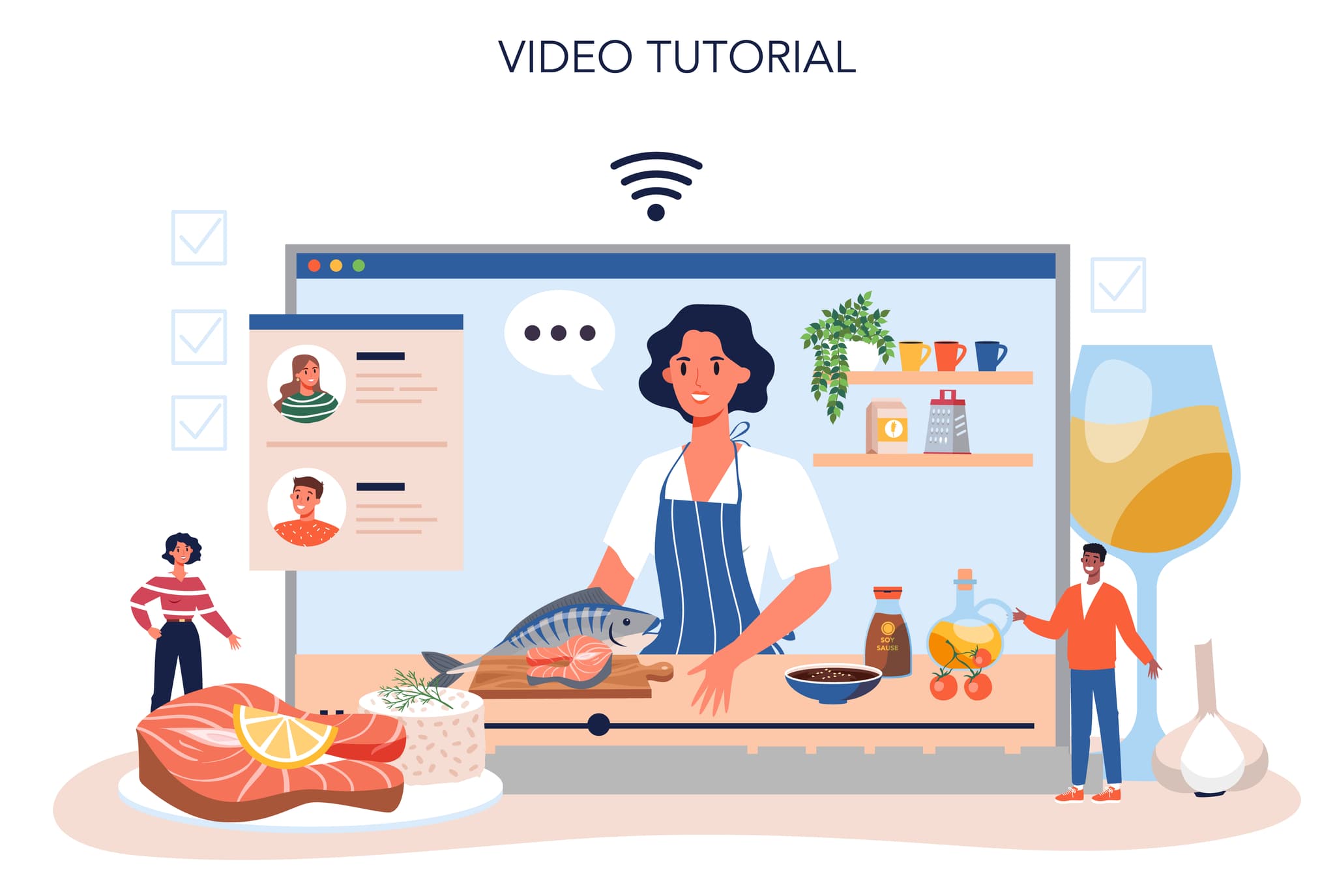Many Internet users surely dream of this: creating their own food blog and earning money with it, maybe even making a living with a food blog. What sounds very utopian doesn't have to be that hard! If you find a good niche in the food sector and put your knowledge on a nicely designed website, you have good chances of success. You have to bring the knowledge and a concept yourself. How you can create an appealing site in a few steps with our help, you will learn now! If you want to get a quick overview first, you should watch the following video!
8 steps to the perfect food blog

Step 1: Create structure and design plan
First of all, you need to develop a plan for your site. It can help to answer the classic W-questions that you probably remember from school.
Questions you should answer before you create your page
Who do I want to address?
What do I want to feature on my site?
Why am I creating a food blog in the first place?
How do I want to proceed?
Where do I want to create my food blog?
You can probably answer some of these questions already, but others will probably make you wonder. So you can already see that you need to clarify the key data of your site exactly: They are the foundation of your site! You can imagine it like a house of cards. If you remove the lower cards, the whole house collapses!
So, it makes perfect sense not to start creating a blog about food and drinks naively, but to work out a precise plan.
This includes working out the structure of your future site!
Subpages that could be present on a food blog
Blog posts
About you
Recipes / cooking instructions
News
Test reports
Contact and Imprint
You will find out more about the content of your food blog later. So stay tuned!
Step 2: Choose the appropriate domain name
If you have done the groundwork and thought about the basic questions around your food blog, it's now time to get down to business: Think about a suitable name for your domain. It should be memorable and in the best case offer a certain recognition value!
INFO: The domain name should be concise and catchy: "foodblog-xy.de" is better than "the-healthy-food-blog-by-xy-for-you.com" (to exaggerate).
When it comes to the domain, it is especially important to make a conscious decision and exercise care. You can't change it afterwards! You can compare the domain name with a brand name: It will be a recognition feature for your blog for many users!
Step 3: Decide on an appealing design
Now it's time to decide on an attractive design for your website. In technical jargon, this is called a design template. This is particularly important because the design of a blog has a significant influence on how long people stay on the blog about food and drink!
TIP: It makes the most sense to choose a design for your food blog that is as timeless as possible! This way you can be sure that it will still be up-to-date in a few years!
At webme.com you can choose from numerous design templates. Many of them are perfect for your own foodblog! We recommend the templates "Semantic" or "Professional". How such a template can look like in raw form, you can see here.
Now you have to fill this template with life and turn it into a foodblog, so that you can present delicious dishes, recipes etc.. How you do that, you will learn in the next steps!
Step 4: Create the page
When all the preparations are done, you are ready to register your site! This is done with a few clicks on the homepage builder. You just have to enter your desired domain and register with mail address and password. Then you can choose a suitable template and you're done!
INFO: You can change the template you select here at any time afterwards!
You can also choose from three packages for your food blog. With the basic package, for example, the creation of the page is completely free! Of course, you can upgrade to another package at any time if you want more features!
TIP: For an extensive food blog with cooking instructions, ingredient lists, etc., an ad-free package is ideal for more professionalism!

Step 5: Fill the food blog with content
After that, you should start creating content and subpages for your food blog. In this list you will find the most important items that should be present on your food blog!
Elements of a good food blog
Your favorite recipes / cooking instructions
Reviews of food and recipes
What you eat every day
New things you try and test out
About you and what drives you
Imprint and contact section
Of course, these are just some of the elements that can be included on your blog! If you have special ideas that make you stand out from other bloggers, that's even better! Deliver good content to entertain your audience. Create an online cookbook, so to speak, with your personal touch: this will make your site stand out extremely!
TIP: When presenting recipes, an intuitive and step-by-step presentation is recommended: First presentation of food / ingredients, then the cooking instructions / preparation and finally presentation of the finished dish!
There are also numerous extras in the homepage builder, with which you can make your site even more professional. Just browse around and you will find tools for an even more professional presentation of food and recipes!
INFO: In the "Extras" section you can easily and conveniently add some practical extensions to your site
From a contact form for easier contacting to a gallery for an appealing presentation of your food and dishes to a map with which you can mark your location, there are some useful extras for food bloggers among them: Just take a look!
Step 6: Networking with social media
Then it's time to connect your newly created food blog with social media like Facebook, Instagram or Twitter. As a soon-to-be food blogger, I probably don't need to tell you this, but social media is extremely important, especially in the blogging scene: this is where you build new connections and contacts and maintain existing ones!
TIP: With the homepage builder you can integrate Facebook comments directly on your website with the help of an extra!
As mentioned, you can embed Facebook directly on your site. You can also easily link social networks like Instagram or Twitter. This way, everything is perfectly linked and users can quickly get from your Instagram page to your homepage and from there to your Twitter feed!
Step 7: Keep the page up to date
Now your side stands: Super! However, you can not rest on your laurels, to stay in the area of food. It goes without saying that a blog needs to be regularly updated with new posts!
INFO: The "News" extra of the homepage builder is ideal for blogging.
Users want to hear new recipes and updates from you regularly: With the "News" extra, you can conveniently publish blog-style news on your website! You can also remove or edit old and no longer relevant content at any time. Users can also leave comments on your entries: That's blogging!
So make sure to interact and share with your audience, that's what makes a good blogger!
But also other content on your site must be up-to-date and reliable: For example, think about your contact details! If a user wants to send you an email but the email address is no longer available, this is not necessarily good for your reputation!
Step 8: Do SEO
Your site is online, looks good, you post regular updates, new recipes, product tests, etc...: All well and good. However, all this does you little good if no one finds their way to your site! This is where SEO, or search engine optimization, comes into play. In short, you have to use SEO measures to get your site a good position in the Google rankings. This involves keywords (i.e. key words) for which you want to rank. You should also, for example, reduce the loading time of your page or pay attention to a correct headline structure.
Links from other sites to your site, so-called backlinks, are also very relevant and a core factor for the Google ranking. If you want to learn more about this, we have summarized a lot about SEO in this section (LINKING)!

Conclusion
Finally, you should know the most important tools and tricks to create not a mediocre, but stunning site in the competitive niche of food blogs! You have learned that as a food blogger you should not start blindly with the creation of your homepage, but should first work out a plan and a structure.
This way, you'll ensure a professional appearance and more page views and visitors who will recreate your recipes. The domain name also plays a key role for your online cookbook: short domain names are preferable from an SEO and usability point of view. The page design also provides recognition value for your blog and should be timeless. Then, after you've created the food blog, I've explained what content (cooking recipes, how to prepare them, the ingredients needed for them, etc.) you should fill it with.
You also learned that with SEO and regularly posting new recipes and content to your site, you'll always have something to do and your project isn't already a goner once the page is created!
Now that you should know everything that should be relevant to your food blog, I hope you have fun creating your page!